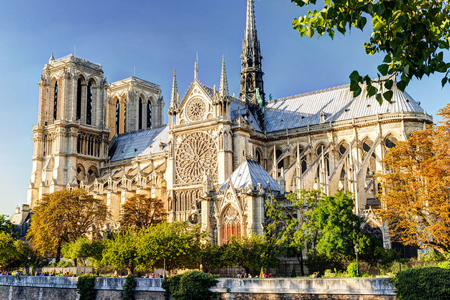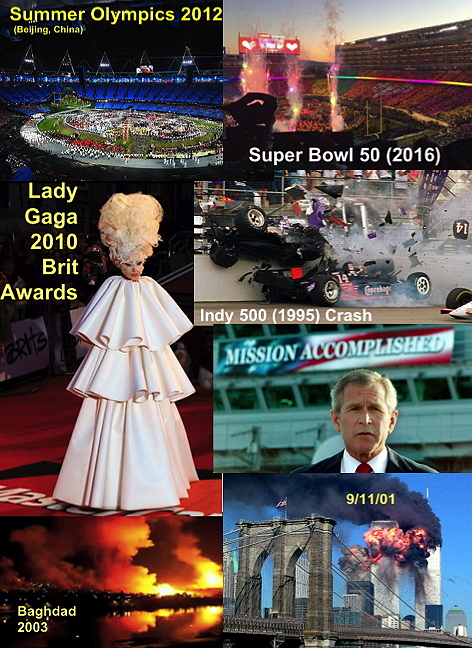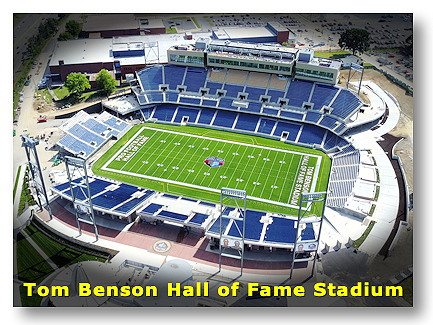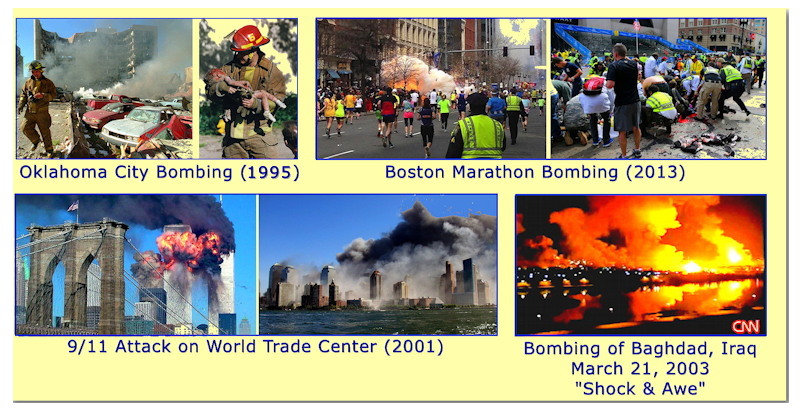This page was last modified on October 16, 2024
PSY 355 Psychology
& Media in the Digital Age
This page was last modified on October 16, 2024 |
Class 16: The Notion of "The Spectacle" • Living in the World of the Spectacle (Outline)
The word "spectacle" comes from the Latin verb "spectare" which means "to look." In English, spectacle tends to have two general meanings: (1) an exhibition or a show or (2) a device used to help seeing (i.e., a pair of glasses).
Different types of spectacles within cultures tend to reinforce the basic values of that culture.
Ancient Roman spectacles included
· Chariot Races (“ludi circenses”)
· Gladiator Contests (“munera”)
· Wild Animal Hunts (“venatio”)
· Triumphs (“triumphi”), Processions (“pompae”), and Re-enacted Naval Battles (“naumachia”)
· Theatrical Performances (“ludi scaenici”)
· Public Executions (“summum supplicium”) including crucifixions, burnings, and being thrown to animals.
Roman values in the spectacles
- Warrior spirit of the founding myths
- Superiority of Rome over others
- Strict social hierarchy
- Criminals need to be degraded & humiliated
Spectacles in Christian Europe

Religious pageants & processions: Feast of Corpus Christi ("Body of Christ") in June, Carnival/Mardi Gras in late winter, Easter, local feasts of the saints in individual villages, towns, & cities
Church architecture as offering vivid sights for people who otherwise lived in plain homes
Christian values in the spectacles
- God's Glory & Majesty
- The divine working via Jesus Christ within human lives: salvation, redemption
- Hierarchy in society
The Nuremberg Rallies (Nazi Germany, 1933-1938)
- "The Cathedral of Light
- “Triumph of the Will (German: Triumph des Willens) is a 1935 Nazi propaganda film
- The film showed German military power & strength: eagles & Swastikas: reminiscent of the Roman Legions from the ancient world.
- Emphasis upon the unity of the German People: everything shown in perfect alignment, marching in identical step
- Showed many Germans in peasant clothing and costume linking the Germans of the 1930s with their ancestors
- Torchlight processions as reminiscent of medieval celebrations in German cities and towns
Victory Parades in Red Square (Moscow, Soviet Union; 1945 and after)
1945 1960 1970
Victory Day Parade in Red Square, May 2019
on the 74th Anniversary of Victory in the Great Patriotic War of 1941-1945.
These Moscow Victory Parades--grand spectacles in a hallowed space--have reflected multiple values of Soviet and Russian culture and history including
- national strength and determination
- honoring the role of countless "ordinary" people in achieving victory
- strong historical memories of the sacrifices the nation endured in the war (over 20 million Soviet citizens died)
The Spectacle in Contemporary Society
 A. Debord's Notion of "The Spectacle"
A. Debord's Notion of "The Spectacle"
Guy Debord (1967/1994) argues that we live in a "media and consumer society, organized around the production and consumption of images, commodities, and staged events"
- strongly connected to the notion of separation and passivity
- uses "the cultural mechanisms of leisure and consumption, services and entertainment, ruled by the dictates of advertising and a commercialized media culture"
Values of contemporary society
- Competition
- Winning
- Success
- Wealth & Money
- Leisure
Major Examples of Spectacle in today's world
- Sports (Olympics, World Series, Super Bowl, March Madness-NCAA Basketball)
- Sports Stadiums: filled with electronic reproduction of the action & advertisements.
- Professional stadiums
- SoFi Stadium (Inglewood, CA • LA Rams; image above)
• High school stadiums

- Tom Benson Hall of Fame Stadium –– McKinley HS ($137 million, 23,000 seats, reconstructed 2015-16, image above)
- Cypress-Fairbanks FCU Stadium — Cypress, TX ($69 million, 11,000 seats, 2006)
- Legacy Stadium — Katy, TX ($70,000, 12,000 seats, 2017)
- McKinney ISD Stadium — McKinney, TX ($70 million, 12,000 seats, 2018)
- Eagle Stadium — Allen, TX ($60 million, 18,000 seats, 2012)
In the current
society as spectacle, the key players often are very
wealthy (society rewards what it values)
B. Terrorism as Spectacle: Domestic and Foreign • Psychological Effects
We live in a world in which terrorism has become more and more prevalent. While there are conflicting definitions of the word "terrorism" here are definitions used by the FBI in the US for two forms of terrorism:
International terrorism: Violent, criminal acts committed by individuals and/or groups who are inspired by, or associated with, designated foreign terrorist organizations or nations (state-sponsored), and,Notice that these definitions do not include mass murder events in which perpetrators act without any ideological goals.
Domestic terrorism: Violent, criminal acts committed by individuals and/or groups to further ideological goals stemming from domestic influences, such as those of a political, religious, social, racial, or environmental nature.
The United States has had its own experiences of domestic terrorism including
- 1995 (April 19) bombing of the Oklahoma City Federal Building
- 9/11/2001 [YouTube Video from NBC NEWS]
- Boston Marathon Bombing (April 15, 2013)
In response to the attacks on 9/11, the United States went to war in both Afghanistan (begun 2001 and ended 2021) and Iraq (begun 2003 and ended 2017). The cost of these wars is estimated at $5 trillion.
- Bombing of Baghdad, Iraq (March 21, 2003) "Shock and Awe" [YouTube Video]

The presence of visual media recording both the acts perpetrated by the terrorists and the response of the government to such events.
- All of the events illustrated above were seen by large television audiences live either immediately after the initial attack or, even, during subsequent attacks themselves.
- In each case the television coverage was non-stop for many hours and, even, days.
- The video recordings of the attacks were played repeatedly so that viewers may have literally watched each event or scene dozens of times.
Potential Psychological Effects of the "Terrorism Spectacle"
- Does watching the spectacle of terrorism lead to major depressive disorder (MDD), post-traumatic stress disorder (PTSD), or other stress and anxiety disorders?
- Mental health effects of 9/11 viewing: "Taken together, the data from the three large-scale WTC telephone interview surveys suggest that exposure to emotionally charged, real-life television images of death and destruction can produce symptoms of PTSD and MDD in children and adults. Vulnerable persons who have other known risk factors, such as women, minority group members, and those with prior traumatic experiences, should exercise caution by limiting their viewing of violent television programs, including news reports." (Eth, 2002, p. 302)
- Robert et al. (2021) summarize the research literature as showing that:
The 24-hour media cycle (including television, newspapers, and social media) turns local disasters into national and international tragedies or “collective trauma.” Prior research demonstrates that, following these events, many in the general population are repeatedly exposed to images of brutal violence through widespread media coverage A number of studies following terrorist attacks in the United States demonstrated that this media exposure may have implications for mental health, with post-traumatic stress symptoms (PTSS) as the most commonly assessed outcome. PTSS symptoms include the re-experiencing, avoidance, hyperarousal, and cognitive distortions that characterize Post-traumatic Stress Disorder (PTSD),but may be assessed in the absence of Diagnostic and Statistical Manual of Mental Disorders Criterion A (i.e., trauma exposure) for PTSD. Positive associations between time spent watching traumatic images on TV or the internet and PTSS have been reported in the general population at 1 month (6), 1 to 2 months, 6 months and even years after terrorist attacks.
Expanding the notion of psychological harms due to terrorism as spectacle to the wider issue of social media as trauma inducing, consider the following:
Scott and her colleagues (2023) offer an overview of the notion of trauma as consisting of 11 different types (some of which are overlapping in their impact). Paralleling those non-media based types of trauma, social media itself can serve to create or augment the multiple types of trauma.
Here are three questions
to ask about Spectacle in the 21st Century World
1. Do you agree or not that the major values in our world today are competition, winning, success, wealth & money, and leisure? If not, what other values do we have in our culture that are equally or almost equally important?
2. Does the notion that spectacles are very important to people today help you understand how our political culture works? Can you think of ways in which political figures use spectacle to attract support from voters, e.g., as below, displaying weapons in ads?
3. Is it possible that the rising rates of anxiety, depression, and other forms of psychological distress in today's world are related to or made more painful because people who watch spectacles compare themselves unfavorably with what they see? Or, as noted just above, people may be exposed to suffering via video images?